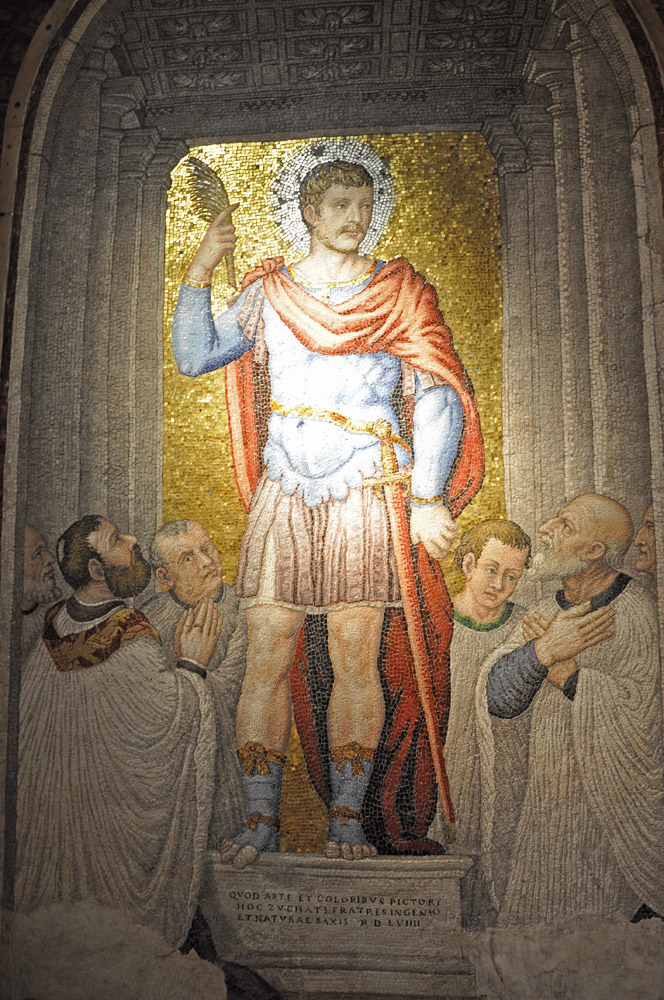When Maximian was informed that Victor was a Christian, he summoned him and demanded an explanation. The saint proclaimed that he had been a Christian from childhood and worshiped only "Jesus Cbrist, son of the living God, born of the Virgin Mary." The emperor then had him imprisoned and tortured for six days, after which he mockingly asked, "How is your health?" When Victor replied, "Christ is my health and my strength" he was subjected to three more days of torture punctuated by offers of preferment and wealth if he would recant. Then he was beaten mercilessly with cudgels and molten lead was poured over him. God kept him from feeling pain from these torments, and at one point he even managed to escape and hide in the imperial gardens. But when the guards recaptured him Maximian finally ordered that he be beheaded and his body exposed to be eaten by wild beasts. However, two beasts guarded the body until it could be taken away by Maternus, the bishop of Milan at the time.
In the image at right St. Victor's attribute is the sword with which he was beheaded. Because the word "Moor" is so often absent from the references, it is no surprise that the image depicts him as a white person. Indeed, even St. Maurice, whose very name identifies him as African, is portrayed as white in many medieval images.
Other Saints of this Name
A number of other martyrs of the time also bore the name Victor. In his article on Victor the Moor in the Acta Sanctorum Godfrey Henschen manages to disentangle his story from the others and survey the history of the various Milanese churches dedicated to Victor the Moor.Saints Victor and Corona, a married couple, are commemorated on May 14. The Roman Martyrology for May 14 draws on earlier martyrologies to summarize her story:
In Syria [the birth into Heaven of] the holy martyrs Victor and Corona, under the Emperor Antoninus [138-161]. The judge Sebastianus made Victor suffer various and horrid tortures. When Corona, the wife of this soldier, began to praise him for his constancy in martyrdom, she saw two crowns come down from the sky, one for Victor and one for her. When this was reported by those who had heard her she was cut in two between two trees and Victor was beheaded.According to Bede's Martyrology Corona was only 16 at the time.1 Although the martyrologies say she was a wife (uxor), her image in Bassano's Adoration of the Shepherds gives her the unveiled blond hair that traditionally signifies a virgin martyr.
Prepared in 2022 by Richard Stracke, Emeritus Professor of English, Augusta University.
HOME PAGE

Francesco and Valerio Zuccato, St. Victor. See the description page for a discussion of why this is most likely St. Victor the Moor and a survey of the other military martyrs by that name.
DATES- Said to have died during the persecution of Diocletian, 303-305.
NAMES
- Sometimes referred to as "Saint Victor, Martyr of Milan"
- In the Middle Ages churches were built in Milan on locations remembered in St. Victor's legend. Thus S. Victoris ad Theatrum, for the place where he managed to escape his guards, S. Victoris ad Ulmum, for the name of the garden where the guards recaptured him, and S. Victoris ad Corpus for the place where his body (corpus) was exposed and guarded by the beasts.
BIOGRAPHY
- Butler, II, 250.
- Acta Sanctorum, May vol. 2, 286-90.
- De S. Victore Martyre, in Analecta Bollandiana, XVII (1898), 172-73.
NOTES
1 Acta Sanctorum, May vol. 3, 265.